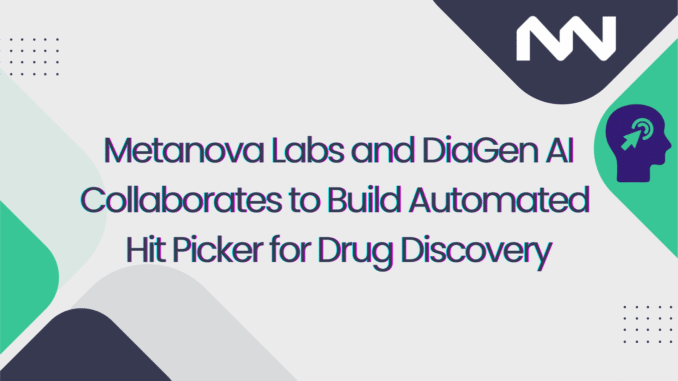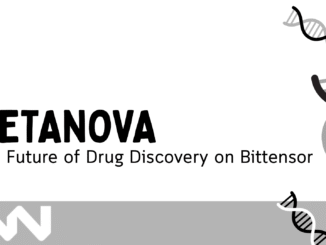
Drug discovery is entering a new era where AI, collective intelligence, and decentralised compute are beginning to reshape how early research is done.
Metanova Labs and DiaGen AI announced a milestone joint venture LOI (Letter of Intent) that will push this shift forward by building an automated, multi-objective hit picking system designed to score, evaluate, and prioritise drug candidates at a massive scale.
This collaboration brings together DiaGen’s bioinformatic and AI capabilities with Metanova’s decentralized virtual screening platform, NOVA, which runs on Bittensor’s Subnet 68.
Together, they aim to automate one of the most tedious and expertise-heavy steps in drug discovery: selecting the best small molecule candidates from millions of possibilities.
Why This Collaboration Matters
Hit picking is still mostly manual. Medicinal chemists sift through ranked lists, cross-checking novelty (independent sources/methods), evaluating potential affinities (relationships), and drawing on years of intuition. As libraries grow from millions to billions of molecules, this method becomes increasingly unsustainable.
Metanova and DiaGen want to fundamentally change the workflow. Their joint system will automate the evaluation of small molecules across:
a. Novelty (This measures how unique or unexplored a molecule is compared to known chemical structures, helping teams prioritise compounds that offer fresh therapeutic potential.)
b. Affinity (This evaluates how strongly a molecule is predicted to bind to a biological target, allowing researchers to quickly identify candidates with the highest likelihood of producing real therapeutic effects.)
c. Target specificity (This assesses whether a molecule interacts with the intended target rather than unrelated pathways, reducing off-target risks and increasing the chances of developing safer, more precise drugs.)
The goal is to compress days or weeks of expert review into seconds of AI-powered analysis, and use decentralised compute to scale discovery far beyond traditional laboratory capacity.
Putting NOVA’s Massive Molecule Library to Work
NOVA, Metanova’s decentralised virtual screening engine, already contains more than 10 million molecules and continues to expand. With the Hit Picker layered on top of it, both teams can screen larger, richer libraries with far greater precision.
Micaela Bazo, CEO of Metanova Labs, highlighted the opportunity clearly, noting that this partnership “automates and scales the way we identify and prioritise the most promising candidates for validation.”
By pairing NOVA’s global compute power with DiaGen’s AI systems, the full pipeline from virtual hit to biological validation becomes faster and more efficient.
What the Joint Venture Will Build
Under the LOI, both teams will co-develop a target interaction-based Hit Picker designed for real-world drug discovery environments. The tool will integrate experimental and proprietary datasets, improving continuously as more data flows through the system.
Key elements of the collaboration include:
1. Co-Development
Both companies will collaborate on the core engine, merging bioinformatics, screening signals, and objective scoring into a unified system.
2. Shared IP and Revenue
The tool and its derivatives will be co-owned. When the Hit Picker is used to create token-gated compound libraries for external biotech or pharma clients, revenues will be shared proportionally based on contributed value.
2. Governance and Next Steps
A joint working group will set the project roadmap, define milestones, and finalise the terms for a definitive joint venture once the prototype is completed and validated technically.
Turning Hits Into Token Gated Libraries
One of the first practical applications will be a curated selection of top NOVA submissions delivered as token-gated compound libraries for enterprise users.
This gives biotech and pharmaceutical companies access to high-quality chemical space filtered by a system capable of scoring millions or billions of candidate molecules.
It also transforms what early discovery looks like. Instead of wading through raw screening output, teams gain immediate access to structured, ranked, ready-to-test molecules with a clear rationale behind each choice.
What This Means for the Future of Drug Discovery
This joint venture represents more than a single product. It signals a shift toward an R&D model where decentralised intelligence, AI optimisation, and tokenised scientific workflows work together to accelerate the path from idea to therapeutic.
By combining Metanova’s collective intelligence engine with DiaGen’s AI-driven development pipeline, the two teams are designing a scalable system that can evaluate chemical space orders of magnitude faster than legacy approaches. And that speed translates directly into value. Greater novelty, more validated hits, faster iteration and a smoother path from virtual screening to wet lab testing.




Be the first to comment